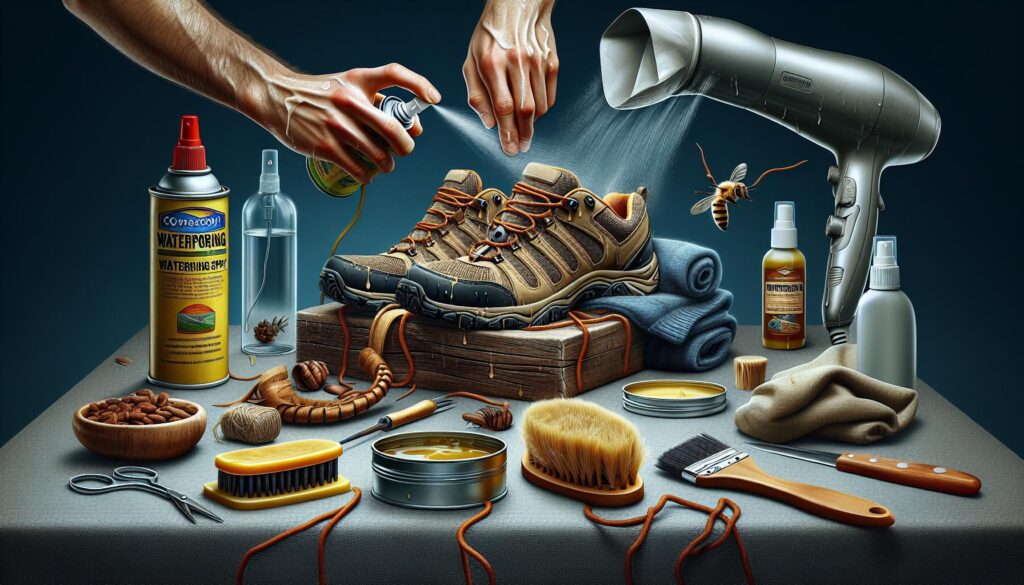Table of Contents
Master the Art of Waterproofing Hiking Shoes: Tested & Trusted Methods
Waterproofing hiking shoes involves the application of a waterproofing spray and seam sealer along the stitching. An essential element in an outdoor enthusiast’s gear, hiking shoes unlock the beauty and wonders of nature.
However, hiking through water-logged, muddy terrains leaves your shoes vulnerable to water intrusion. Ensuring your feet stay dry and cozy necessitates waterproofing your hiking shoes. By integrating a few straightforward steps, you can keep your shoes invincible against water and enhance the joy of your hiking sojourns without the distress of water-soaked shoes.
In this guide, we’ll uncover proven methodologies to waterproof your hiking shoes and prep you for any climatic uncertainties you might experience during your outdoor excursions.
Perks of Waterproofing Hiking Shoes
Waterproofing hiking shoes boasts numerous benefits. Keeping your feet dry and snug sits atop the list. Hiking can usher in unpleasant elements like rain, puddles, and moist terrain, possibly leading to water-soaked and uncomfortable feet. By waterproofing your hiking shoes, you ascertain the dryness of your feet and ward off unwanted moisture. This could notably uplift your hiking adventure, allowing you to concentrate on the mesmerizing views and rigorous trails.
Further, preventing blisters and foot infections is another plus of waterproofing your hiking shoes. Wet shoes can result in friction against your feet, triggering painful blisters. Moisture also fosters bacterial and fungal growth, escalating the risk of foot ailments. Ensuring your shoes are waterproof would minimize these issues, granting you a discomfort-free, painless hike.
Lastly, waterproofing your hiking shoes can prolong their usability. Persisting exposure to water and dampness can cause the shoe materials to degrade quicker, truncating their lifespan. By deploying waterproofing techniques or products, you can shield your shoes from water impairment and boost their durability. This ensures your investment in high-quality hiking shoes is enduring, leading to long-term cost savings.
Usual Reasons for Hiking Shoe Leakage
Hiking shoes leak due to several reasons. An everyday cause is wear and tear of the outdoor material. Consistent exposure to harsh terrains and severe climatic conditions can weaken the material and trigger crack formation, without obstructing water penetration. Another usual reason is inadequate waterproofing. Shoes insufficiently treated with waterproofing spray or wax fail to ward off water, resulting in leaks. Moreover, incorrect cleaning methods can also lead to shoe leakage. Harsh cleaning agents or machine washing can damage the waterproofing layer or strip it off entirely.
Therefore, it is vital to duly care for hiking shoes, including routinely waterproofing them and employing gentle cleaning mechanisms, to make sure they remain waterproof and supply the requisite protection during outdoor activities.
Evaluating the State of Your Hiking Shoes
Assessing the state of your hiking shoes comes first in the process of waterproofing. Begin by checking for any signs of wear and tear on the shoes. Examine the soles for indicators of excessive usage, such as smooth spots or evident damage. Look for split seams or cracks in the upper part of the shoes. These instances might hint towards potential leakage points.
To identify the specific parts where water might be gaining entry into your shoes, carry out a simple test. Fill a sink with water and plunge the shoes in. Look for any water that might be seeping through onto your shoes, giving particular attention to vulnerable parts like the seams, welts, tongue, and lace holes.
Assess the extent of the current waterproofing treatment of your shoes. If they were originally waterproof, but the effectiveness has dwindled, it might be time to restore the treatment. Look for indications of degraded or aging waterproof coatings on the shoes. If the coating has worn out, reapply a waterproofing product.
Cleaning Hiking Shoes Prior to Waterproofing
Dealing with dirt, mud, and debris: It is essential to clean your hiking shoes thoroughly before waterproofing them. Begin by removing all dirt, mud, or debris from the shoes. Use a stiff brush to “deep-clean” away the grime from the surface. Concentrate on the nooks and crannies. By eliminating the dirt and debris, the waterproof agent’s adherence will be better.
Selecting proper cleaning agents: After the loose dirt has been removed, it’s time to clean your hiking shoes. Choose a mild cleansing agents or a specific shoe cleaner that agrees with your shoe’s materials. Apply the cleaning agent onto a soft cloth or sponge and gently rub it onto the shoes in circular motions. Be careful not to employ forceful methods or abrasive cleaners which could damage the shoe’s surface.
Drying the shoes efficiently: Once the shoes are clean, ensure they are dried effectively before applying the waterproofing treatment. Absorb excess moisture with a clean towel. Then, position the shoes in a well-ventilated space, far from any direct heat sources. Allow them to air dry for a minimum of 24 hours or until completely dry. This step is crucial to prevent moisture from getting stuck within the shoes, leading to the growth of mildew or mold.
Utilizing Waterproofing Sprays or Waxes
When waterproofing hiking shoes, using the correct product tailored to the shoe material is critical. Hikers commonly opt for waterproofing sprays or waxes for protection against water and damping, while retaining breathability. These products create a shield on the shoes’ surface, repelling water droplets and keeping your feet dry during your outdoor adventures.
It is essential to choose the right product for your shoe material to ensure the best results. Waterproof sprays are widely selected for leather and fabric shoes. These sprays are easy to apply and effective on diverse types of materials. On the flip side, waxes are more suited for full-grain leather boots as they provide a thicker, long-lasting layer of protection.
Even application of waterproofing spray or wax is important to ensure complete coverage. Start by cleaning your shoes and removing any dirt or debris. Then, spray or apply the product uniformly using a sponge or a cloth, focusing on seams and other areas prone to water penetration.
After applying the waterproofing product, allow your shoes to dry naturally. Refrain from using direct heat sources such as hair dryers that may damage the material. Furthermore, allowing ample curing time for your shoes after the application helps the product bond effectively with the shoe surface, boosting its waterproofing abilities.
Employing Waterproofing Sealants or Membranes
Unlocking the Secret to Waterproof Hiking Shoes: Verified Methods Unveiled
The thrill of an outdoor adventure begins with the comfort of your feet. Good hiking shoes provide that comfort. But every experienced hiker knows the importance of waterproofing their hiking shoes. Waterproofing sealants or membranes provide a protective layer on your hiking shoes, creating an impregnable barrier against water and keeping your feet dry and snug for your outdoor escapades. Utilizing these products enhances your hiking experience in numerous ways:
- Fends off water damage: Sealants or membranes act as protective armor for your hiking shoes, fending off water absorption and consequent damage.
- Boosts durability: Sealing your shoes with waterproofing agents makes them resilient against the wear and tear caused by exposure to water.
- Optimizes breathability: Some sealants allow air circulation while simultaneously keeping water at bay, ensuring excellent ventilation.
- Long-lasting benefits: If applied properly and maintained regularly, these waterproofing techniques can offer extended protection against water.
Before proceeding with the application, it is crucial to clean and dry your shoes thoroughly for the best adhesion and effectiveness of the waterproofing agents. Moreover, each product might come with distinctive instructions for application, which need to be followed diligently.
Reviving the DWR (Durable Water Repellent) Coating
Durable Water Repellent, or DWR coating, forms the first line of defense against water for your hiking shoes. This protective coating averts water from seeping into your shoe material, thereby ensuring dryness even in damp conditions. However, with consistent use and exposure to elements, this DWR coating may wear off, reducing its water repellence.
To sustain the waterproof nature of your hiking shoes, it is vital to recognize the signs of a deteriorating DWR coating. A quick examination can be by sprinkling some water onto the shoe surface. If the water forms beads and rolls off, the DWR coating is intact. If the water permeates into the fabric, it’s a clear sign for the need to replenish your DWR coating.
Strategic application of the DWR coating can reinforce your shoe’s waterproofing. Begin by comprehensively cleaning your shoes. Post this, as per the manufacturer’s guidelines, apply a fresh coat of DWR evenly across the shoe surface. This new layer needs enough time to cure and dry before your shoes are ready to brave the outdoors again.
Effective Cleaning and Caring of Hiking Shoes
Maintaining the waterproof feature of your hiking shoes requires regular cleaning and care.
Start by cleaning and drying your shoes after each use. Use a damp cloth to wipe off dirt or debris without damaging the shoe surface. Avoid harsh cleaning methods which might have adverse effects on the shoe material, compromising their waterproof qualities.
For stubborn stains and odors, a mixture of mild soap and water can be used. Apply the mixture and gently scrub the troubled area using a soft-bristle brush or sponge. Rinse thoroughly and leave them out to air dry in a well-ventilated place. Dodging direct heat sources like hair dryers or radiators will save your shoes from potential damage.
Taking care of the waterproofing on your hiking shoes contributes to their longevity and consistent performance. By cleaning and drying them regularly, you maximize their lifespan and continual dry comfort for all outdoor adventures.
Periodic Reapplication of Waterproofing
At times, even the best-applied waterproofing treatments might need a retouch. Several indicators give away the need for reapplication:
- Appearance: If your shoes start to look wet with only marginal exposure to moisture, it suggests the need for waterproofing reapplication.
- Water Absorption: When your shoes begin absorbing water rather than deflecting it, it is a glaring sign that the waterproofing has worn off.
- Breathability: If your feet feel stifling or your shoes become water-logged, it’s time for a waterproofing do-over.
Several waterproofing techniques exist, and the choice depends on your preference and shoe type:
- Spray-On Waterproofing: This method is effortless and yields a protective barrier against moisture while sustaining the shoe’s breathability.
- Wax-Based Waterproofing: Particularly ideal for leather hiking shoes, wax-based products form a durable waterproofing layer.
- Waterproofing Sealants: These are preferred for fabric or synthetic shoes as they penetrate the material’s fibers, forming a barrier.
For effective waterproofing, always follow the manufacturer’s instructions regarding the drying time, ensuring comprehensive adherence. Also, avoid wearing the shoes until fully dry as it might affect the finish of the waterproofing layer.
Routine Inspection and Repair of Leaks
Consistent checks for potential leaks and timely repairs play a vital role in sustaining the waterproof nature of your hiking shoes. Regular inspections help to keep an eye out for potential leaks before they become a significant problem. Pay special attention to the seams and stitching as these are common grounds for leakage. Be vigilant for signs of damage, such as holes or fraying of the fabric, and address them immediately.
If minor leaks are found, apply a waterproof adhesive to seal the area. Follow the application instructions provided by the manufacturer for completely sealing off the leak. Another viable option is using a waterproofing spray or wax to treat the entire shoe, simultaneously repairing minor leaks and reviving the shoe’s waterproof capabilities.
Periodic inspection and timely repairs form the cornerstone of keeping your hiking shoes waterproof for any outdoor adventure. These proactive measures ensure your shoes are always trail-ready, no matter what the weather throws at you.
Frequently Asked Questions About Making Hiking Shoes Waterproof
How Can I Make My Hiking Shoes Waterproof?
Waterproofing hiking shoes involves the use of waterproofing sprays or wax that create a protective sheath on the shoe’s exterior. These products coupled with a reliable waterproof sealant ensure optimal protection against moisture ingress. Waterproof socks and shoe covers can provide additional protection during wet hikes, rounding off the waterproofing process.
What Is The Best Way To Waterproof Hiking Shoes?
Practical Guide to Waterproofing Hiking Shoes: Expert Tips and Techniques
For those who love outdoor adventures, hiking shoes are your trusty allies. However, their core strength lies in their ability to resist water, and that’s where waterproofing comes into play. Waterproofing sealants or membranes are key to achieving this as they form a barrier against water, keeping your feet dry and making strides comfortable. Here’s why these products are beneficial:
- Defend against water damage: By creating a protective outer layer on your shoes, these sealants or membranes inhibit water absorption and keep damage at bay.
- Boost resilience: Waterproofing enhances durability, fortifying your shoes against potential wear and tear caused by water exposure.
- Promote breathability: Certain sealants or membranes facilitate proper ventilation, letting air in while locking water out.
- Long-term effectiveness: With correct application and maintenance, these substances can offer extended protection against water.
Preparation is key. Before putting sealants or membranes to use, clean and dry your shoes thoroughly for better adhesion and optimal results. Adhere strictly to the manufacturer’s instructions while applying the substances as requirements might vary with different products.
Restoring DWR (Durable Water Repellent) Coating
Knowledge of the role of DWR coating — a specialized layer responsible for retaining dryness within shoes — is crucial. Over time, this coating loses its water-repelling ability due to frequent usage, and exposure to dirt and washing.
Regular checks and replenishments of your worn-out DWR coating ensure your hiking shoes stay waterproof. An effective way to check is to sprinkle a few drops of water on the shoe surface. If the water forms beads and rolls off, your DWR coating is doing its job. If the water penetrates the fabric, it’s time for a fresh layer of DWR coating.
Effective application of DWR coating ensures optimal waterproofing. Clean your shoes thoroughly to remove dirt or debris. Follow this up by applying the DWR coating evenly on the shoe material, adhering to the manufacturer’s instructions. Once applied, give ample time for the new coating to cure and dry.
Importance of Regular Cleaning and Care
To maintain the waterproofing of your hiking shoes, clean and care for them regularly. After each hike, ensure you clean and dry your shoes. Wipe the shoes with a damp cloth, removing any dirt or debris — avoid harsh cleaning processes that may dent the shoe material.
For persistent stains and odors, combine mild soap and water as a cleaning solution. Gentle scrubbing using a soft-bristle brush or sponge should rid your shoes of these nuisances. After a thorough rinse, let the shoes air dry in a suitably ventilated area, avoiding direct heat sources which could cause damage.
Maintaining waterproof properties contributes to the durability and performance of your hiking shoes. Regular care and cleaning prolong their lifespan, ensuring dry and comfortable feet on all your expeditions.
Reapplication of Waterproofing
Sometimes, even thoroughly waterproofed shoes might require a touch-up. There are several signs to watch out for:
- Appearance: If moisture leaves visible wetness on your shoes, it’s time to reapply the waterproofing.
- Water Absorption: If your shoes start more absorption rather than repelling, you’ve lost your waterproofing.
- Breathability: Uncomfortably sweaty feet or shoes feeling water-heavy signal the need for waterproofing reapplication.
There are a variety of waterproofing techniques available, each suitable to different types of shoes and user preferences:
- Spray-On Waterproofing: Quick, easy, and effective, this technique maintains breathability while providing a moisture barrier.
- Wax-Based Waterproofing: Ideally suited for leather hiking shoes, these products create a strong, water-resistant layer.
- Waterproofing Sealants: These are ideal for fabric or synthetic shoes as they create a barrier penetrating the material’s fibers.
Following the drying time indicated in the manufacturer’s instructions allows the product to fully bond with the shoes. Moreover, ensure the shoes are completely dry before wearing them to allow the waterproof mix to properly set.
Routine Checks and Leak Repairs
Frequent shoe inspections and timely leak repairs are key longevity tactics for your waterproof hiking shoes. Delve into the habit of checking for any worrying signs before they stack up — focus on the seams and stitching as they are common leak-prone zones. Locate any damage signs — like holes or loose threads — and address them instantly.
If a minor leak springs up, there are many ways to seal it off and restore the waterproof property of your shoes. Using a waterproof adhesive according to the manufacturer’s instructions helps. Treating the whole shoe with a waterproofing spray or wax can nip small leaks in the bud and reestablish its water resistance.
By putting into practice regular checks and timely repairs, you’ll keep your hiking shoes reliably waterproof. These measures ensure your shoes are always adventure-ready, regardless of the weather.
Frequently Asked Questions on Making Hiking Shoes Waterproof
How Can I Make My Hiking Shoes Waterproof?
To make your hiking shoes waterproof, using waterproof sprays or waxes that externally coat the shoes will do. Supplement this with a waterproof sealant for an extra protective layer. For added safety during damp hikes, consider wearing waterproof socks or shoe covers.














